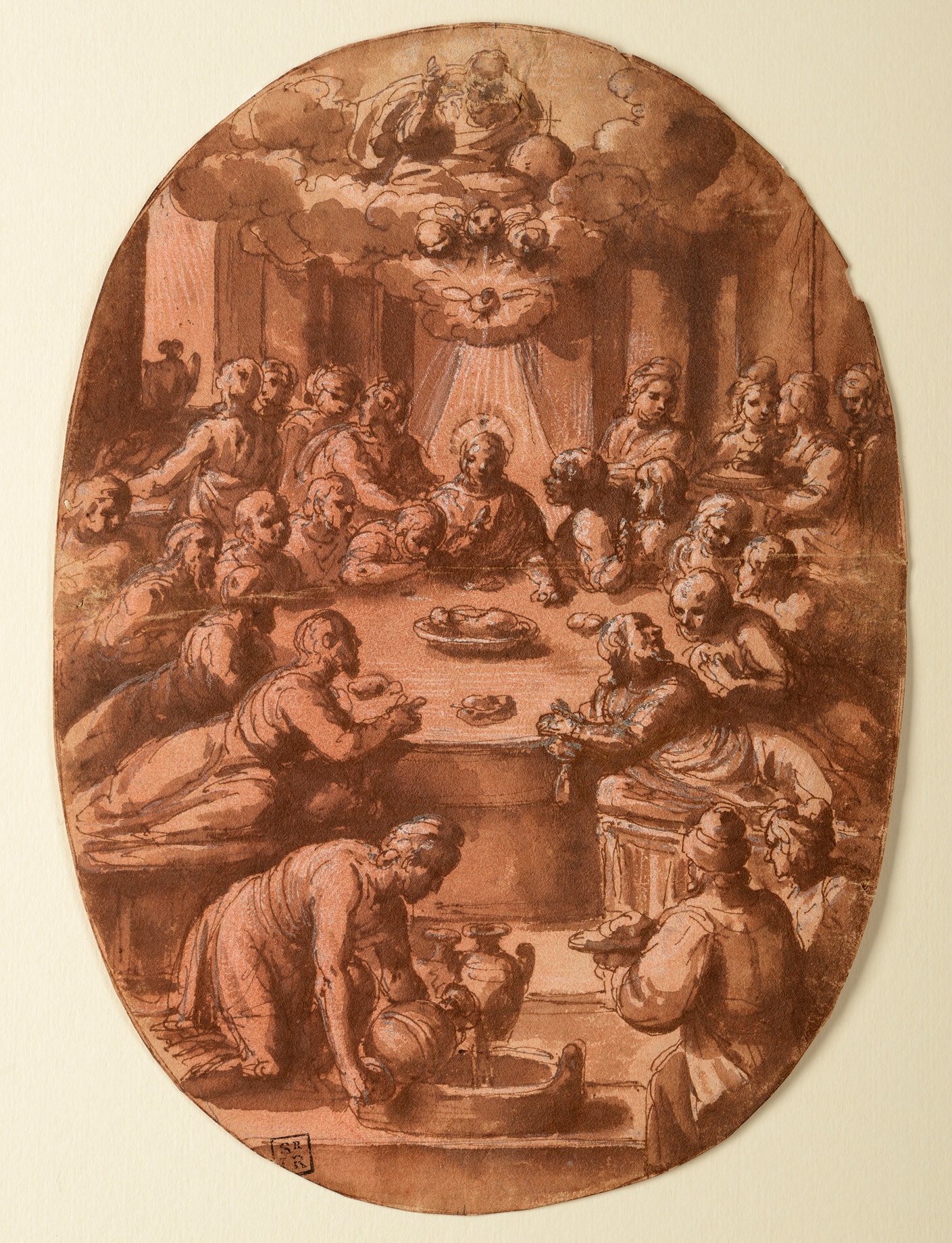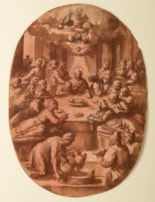Cesare ROSSETTI
(Rome c.1565 - Rome 1644)
The Last Supper
Sold
Pen and brown ink and brown wash, heightened with white, on paper washed with a reddish tone.
Traces of a framing line in brown ink.
Inscribed Mauro Oddi / La Cene / Vente Kaieman 1859 / Collection Sir J. Reynolds on the verso.
269 x 192 mm. (10 5/8 x 7 1/2 in.)
Traces of a framing line in brown ink.
Inscribed Mauro Oddi / La Cene / Vente Kaieman 1859 / Collection Sir J. Reynolds on the verso.
269 x 192 mm. (10 5/8 x 7 1/2 in.)
An early drawing by Cesare Rossetti, the present sheet can be compared stylistically with a study of Christ at the Column in the British Museum and a large drawing of The Crucifixion, sold at auction in 1997, as well as a drawing of The Virgin and Child in Glory with God the Father and Angels and Saints which was on the art market in Paris in 2006. Similar drawings by the same hand include a study of Solomon Receiving the Queen of Sheba, in the Art Institute of Chicago, and a Martyrdom of Saint Peter at Christ Church in Oxford.
This drawing bears the collector’s mark of the 18th century painter Sir Joshua Reynolds (1723-1792). The leading portrait painter in England, Reynolds’ success and fame allowed him to assemble one of the largest collections of paintings, drawings and prints of his day. His collection of several thousand drawings, mostly Italian works of the 16th and 17th centuries, was dispersed in two auctions in London in 1794 and 1798. The present sheet later entered the collection of D. Kaïeman (1796-1857), a councillor at the court of appeal in Brussels, whose collection of 1,371 drawings was dispersed at auction in Paris in 1858.
This drawing bears the collector’s mark of the 18th century painter Sir Joshua Reynolds (1723-1792). The leading portrait painter in England, Reynolds’ success and fame allowed him to assemble one of the largest collections of paintings, drawings and prints of his day. His collection of several thousand drawings, mostly Italian works of the 16th and 17th centuries, was dispersed in two auctions in London in 1794 and 1798. The present sheet later entered the collection of D. Kaïeman (1796-1857), a councillor at the court of appeal in Brussels, whose collection of 1,371 drawings was dispersed at auction in Paris in 1858.
The Roman painter Cesare Rossetti was born around 1565 and, according to Giovanni Baglione’s Le vite de pittori, scultori ed architetti of 1642, began his artistic career during the pontificate of Sixtus V; that is, between 1585 and 1590. He is, however, first documented only in 1593, when he is recorded as a member of the Accademia di San Luca. He was a pupil and assistant of the painter Giuseppe Cesari, called Cavaliere d’Arpino, of whom he became a close friend and collaborator. (Indeed, Rossetti said of Arpino, in a trial transcript of April 1607, ‘we are friends together and we were brought up [together] from infancy’.)
Baglione records that Rossetti painted several monochrome scenes from the Passion for the Olgiati chapel in the Roman church of Santa Prassede, where Arpino worked on the vault frescoes in the late 1580s and early 1590s; Rossetti’s work in the chapel remains today, although in poor condition and difficult to read. The young artist also painted monochrome frescoes for the Sala dei Capitani in the Palazzo dei Conservatori on the Campidoglio, beneath frescoes by Arpino, as well as a cycle of scenes from the life of Saint Caesarius of Africa for the church of San Cesareo de Appia in Rome; a project supervised by Arpino but executed by Rossetti, probably together with Pasquale Cati, between 1600 and 1603. Rossetti also seems to have painted several works after drawings by Arpino, including two scenes of martyrdom in the Roman church of Santa Maria in Traspontina and some mosaics in the Vatican. In 1606 he is listed as a member of the pontifical academy of the Virtuosi del Pantheon. Rossetti also worked at Santa Maria in Aracoeli, San Silvestro al Quirinale and Santa Maria Prassede, and decorated the façades of a number of Roman palaces. He also painted religious and devotional easel pictures, often on a small scale.
Relatively few drawings by Cesare Rossetti have been identified, and of these very few can be connected to known paintings by him. Unlike Arpino, who displayed a particular preference for drawing in red or black chalk, Rossetti seems to have worked, as a draughtsman, mainly in pen and ink, although a number of chalk drawings are known. Drawings by or attributed to Rossetti are today in the British Museum, the Fitzwilliam Museum in Cambridge, the Art Institute of Chicago, Christ Church in Oxford, the Louvre, the Albertina in Vienna, and elsewhere. An interesting series of ten drawings of scenes from the Trojan War, each shaped in a distinctive way and several inscribed with the artist’s name, were on the art market in 1983 and are now dispersed among different private collections; these may have been studies for small paintings to be set into a decorative scheme.
Provenance
Sir Joshua Reynolds, London (Lugt 2364)
By descent to his niece, Mary Palmer, later Marchioness of Thomond
The posthumous Reynolds sales, London, A. C. de Poggi, 26 May 1794 onwards or London, H. Philips, 5-26 March 1798
D. Kaïeman, Brussels
His posthumous sale, Paris, Hôtel des Commissaires-Priseurs, 26 April – 1 May 1858, lot 91 (as Girolamo Marchesi: ‘La Cène. – Dessin à la plume, fortement arrêté et lavé de bistre, sur fond bistré.’)
The Abbé Thuliez (possibly Abbé Pierre-Joseph Thuliez, Cambrai), with his collector’s mark (Lugt 2395b) on the verso
Anonymous sale, New York, Christie’s, 24 January 2001, lot 26 (as Roman School, Late 16th Century)
Yvonne Tan Bunzl, London.




